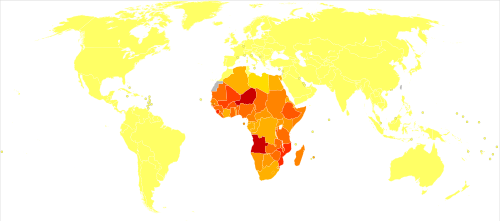Schistosomiasis, or bilharzia, is a parasitic disease caused by trematode flatworms of the genus Schistosoma. Larval forms of the parasites, which are released by freshwater snails, penetrate the skin of people in the water. S. haematobium causes urinary disease and is mainly found in Africa and to lesser extent in the Middle East. S. mansoni is found in Africa, South America and the Caribbean, and S.japonicum in the Far East.
Disability caused by Schistosomiasis (image from Wikimedia Commons)
In the body, the larvae develop into adult schistosomes, which live in the blood vessels. The females release eggs, some of which are passed out of the body in the urine or faeces. Others are trapped in body tissues, causing an immune reaction. ‘Katayama fever’ can occur some weeks after primary infection, but predominantly the disease is chronic. It is also known as bilharzia.
In urinary schistosomiasis (S. haematobium) there is progressive damage to the bladder, ureters and kidneys.
In intestinal schistosomiasis there is intestinal damage, progressive enlargement of the liver and spleen, and portal hypertension leading to oesophageal varices.
Control of schistosomiasis is based on drug treatment, snail control, improved sanitation and health education.
Further info
The Edinburgh-Malawi ‘Labyrinth’ case on Urinary Schistosomiasis A 12 year old boy with haematuria is excellent and tells all you need to know about clinical and some public health aspects. Doesn’t cover life cycle or pathophysiology. It was written by Anthony Butterworth.
 A transmission site: Lake Albert, Uganda (Anthony Butterworth)
A transmission site: Lake Albert, Uganda (Anthony Butterworth)
The CDC page on Schistosomiasis life cycle is excellent and you can also find parasite images there, and much more info linked from the CDC Schistosomiasis page. There is a particularly high quality, single page of detailed professional info.
Wikipedia on Schistosomiasis is pretty good.
Online lecture from Dr Neil Kennedy, Malawi (45 mins) is good.

